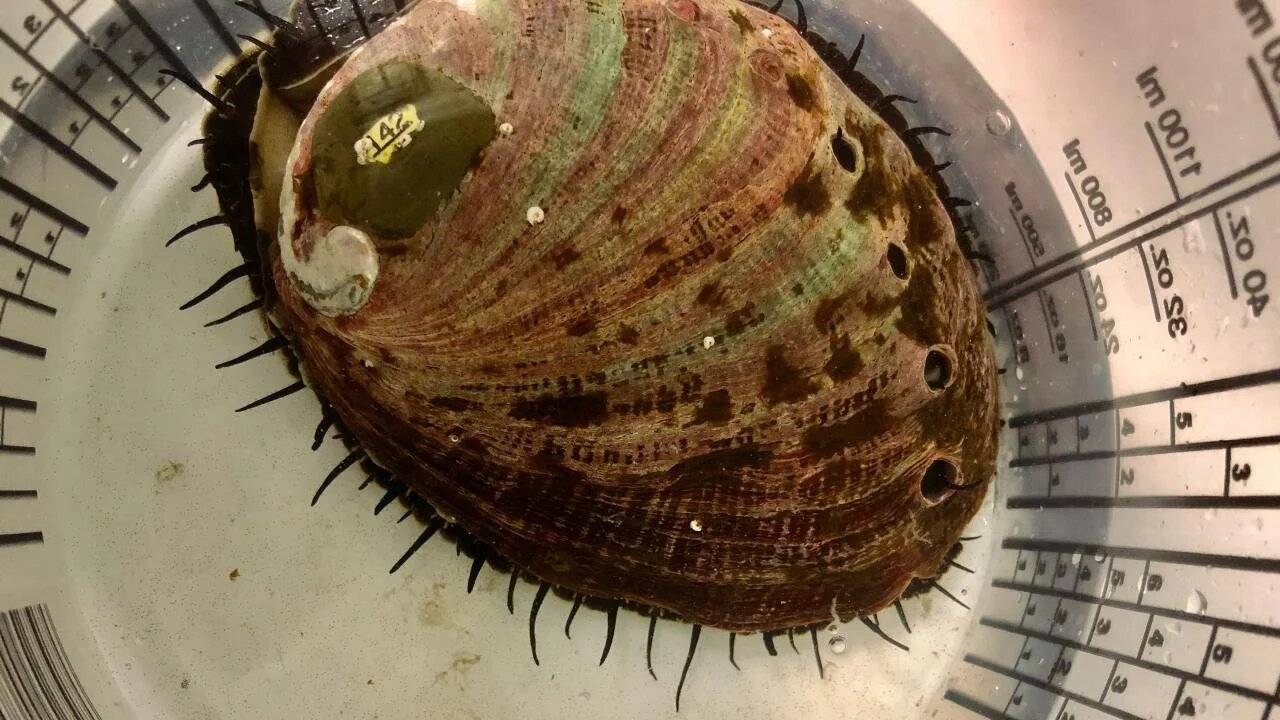Stressful childhoods can affect an individual’s adult years and influence future generations. Scientists at the University of California, Davis, found a similar pattern holds true for red abalone exposed as babies, and again as adults, to the stress of ocean acidification.
Their study, published in the journal Global Change Biology, found that the negative impacts of ocean acidification—a byproduct of carbon dioxide emissions—on red abalone can last within and across generations. Buffering against ocean acidification at crucial life stages can help ease these effects for captive and commercially raised red abalone, while informing efforts to conserve wild abalone, the study said.
“For red abalone, if your parents were exposed to ocean acidification, it does impact your ability to handle stress,” said lead author Isabelle Neylan, a Ph.D. student at UC Davis Bodega Marine Laboratory when the study was conducted and currently a postdoctoral researcher at Louisiana State University. “It’s carrying over within that generation and on to the next generation.”
The research is part of the broader puzzle of efforts working to save the struggling species, which is endemic to California and listed on the International Union for Conservation of Nature’s Red List as critically endangered. The giant sea snails with iridescent shells are the most common of the eight abalone species found off the coast of California, but habitat degradation and the effects of climate change have decimated their numbers.
Spawn, expose, repeat
For the study, the scientists first spawned adult red abalone. They then exposed about half of the offspring to current ocean conditions and the other half to near-future, highly acidic conditions for the first three months of life.
They raised the surviving animals for four years before exposing them again to high or low acidity treatments for 11 months as adults. Then they measured their reproductive potential via ultrasound and their growth.
Finally, they spawned these animals and exposed the second generation’s offspring to high or low acidity to analyze carryover impacts of ocean acidification across generations.
The scientists found that early-life exposure to ocean acidification decreased the abalones’ adult growth rate even after five years, especially when re-exposed as adults. Ocean acidification reduced the ability of adults to reproduce, even for those not exposed as babies. Also, the negative effects the parents experienced carried over to reduce the survival and growth of the next generation.
The experiment revealed that abalone babies were resilient to ocean acidification for two to three weeks, but that three months of ocean acidification exposure resulted in stress and death. That finding gives abalone growers—for commercial aquaculture or captive-breeding recovery programs—a clearer indication of when they should buffer the water chemistry to help protect abalone.
The future is (sometimes) now
“We were looking to see if your parent was exposed, does it buffer you from the impacts? That wasn’t the case,” Neylan said. “The more you get hit, the worse it is, but there are glimmers of hope.”
For instance, Neylan said some red abalone families do better than others. Adults, overall, were fairly resilient to ocean acidification. Adults were smaller, but they successfully spawned, with no significant mortality. As with many life forms, however, the young are the most vulnerable. In the wild, strong coastal upwelling events that bring acidic water from the ocean depths to the surface often take place just as red abalone are spawning.
Upwelling is usually intermittent and driven by coastal surface winds. But the highly acidic conditions, or “high pCO2,” experienced by abalone in the experiment already occur in short pulses during upwelling events off California’s coast. Climate models predict that high upwelling levels are expected to become more common and last longer as carbon dioxide emissions continue to fuel ocean acidification and strengthen coastal winds that trigger upwelling.
A California icon
Red abalone can live 50 years or more and are an important kelp forest species. For thousands of years, they have played a central role in the diet and cultural history of the region’s coastal Native people.
“Red abalone is a California icon,” said co-author Daniel Swezey, a research scientist with the UC Davis Coastal and Marine Sciences Institute and its Bodega Marine Laboratory. “Aside from being beautiful, big and long-lived, they have tremendous cultural cache and a deep history. They mean a lot to a lot of people.”
But they face multiple, often intertwining threats—from warming ocean temperatures and disease to crashing kelp forests, ravenous purple sea urchins, and habitat degradation. These factors led to the closure of the red abalone fishery in 2018 until at least 2026.
“The fishery is in bad shape; kelp hasn’t really recovered; urchin populations are mind-bogglingly high,” Swezey said. “The question now is, what dents can we make in that to give abalone a chance to recover? It’s a tall order, but we’re on the case.”
More information:
Isabelle P. Neylan et al, Within‐ and transgenerational stress legacy effects of ocean acidification on red abalone (Haliotis rufescens) growth and survival, Global Change Biology (2023). DOI: 10.1111/gcb.17048
Citation:
Ocean acidification creates legacy of stress for red abalone, study finds (2023, December 6)
retrieved 7 December 2023
from https://phys.org/news/2023-12-ocean-acidification-legacy-stress-red.html
This document is subject to copyright. Apart from any fair dealing for the purpose of private study or research, no
part may be reproduced without the written permission. The content is provided for information purposes only.


